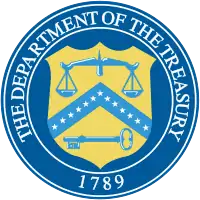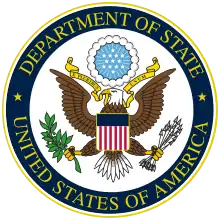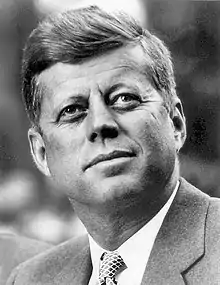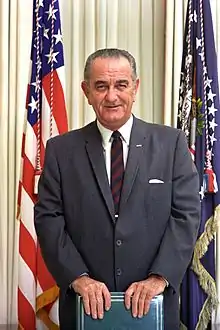C. Douglas Dillon
Clarence Douglas Dillon (born Clarence Douglass Dillon; August 21, 1909 – January 10, 2003) was an American diplomat and politician, who served as U.S. Ambassador to France (1953–1957) and as the 57th Secretary of the Treasury (1961–1965). He was also a member of the Executive Committee of the National Security Council (ExComm) during the Cuban Missile Crisis.
C. Douglas Dillon | |
|---|---|
.jpg.webp) Dillon in 1955 | |
| 57th United States Secretary of the Treasury | |
| In office January 21, 1961 – April 1, 1965 | |
| President | John F. Kennedy Lyndon B. Johnson |
| Preceded by | Robert B. Anderson |
| Succeeded by | Henry H. Fowler |
| United States Under Secretary of State | |
| In office June 12, 1959 – January 4, 1961 | |
| President | Dwight D. Eisenhower |
| Preceded by | Christian Herter |
| Succeeded by | Chester Bowles |
| Under Secretary of State for Economic Growth, Energy, and the Environment | |
| In office July 1, 1958 – June 11, 1959 | |
| President | Dwight D. Eisenhower |
| Preceded by | William L. Clayton |
| Succeeded by | George Ball |
| United States Ambassador to France | |
| In office March 13, 1953 – January 28, 1957 | |
| President | Dwight D. Eisenhower |
| Preceded by | James C. Dunn |
| Succeeded by | Amory Houghton |
| Personal details | |
| Born | Clarence Douglass Dillon August 21, 1909 Geneva, Switzerland |
| Died | January 10, 2003 (aged 93) New York City, New York, U.S. |
| Political party | Republican |
| Spouse(s) | Phyllis Chess Ellsworth
(m. 1931; died 1982)Susan Sage
(m. 1983) |
| Children | 2, including Joan |
| Parents | Clarence Dillon Anne McEldin (née Douglass) |
| Education | Groton School |
| Alma mater | Harvard University (BA) |
| Signature | |
| Military service | |
| Allegiance | |
| Branch/service | |
| Rank | |
| Battles/wars | World War II |
| [2] | |
Early life
Dillon was born on August 21, 1909, in Geneva, Switzerland, the son of American parents, Anne McEldin (née Douglass) and financier Clarence Dillon. Although Dillon grew up as a patrician, his paternal grandfather, Samuel Lapowski, was a poor Jewish emigrant from Poland.[3] After leaving Poland, his grandfather settled in Texas after the American Civil War and married Dillon's Swedish-American grandmother. Dillon's father later changed his family name to Dillon, an Anglicization of "Dylion", his grandmother's maiden name.[3] Dillon's mother was descended from the Graham family, Lairds of Tamrawer Castle at Kilsyth, Stirling, Scotland.
Dillon began his education at Pine Lodge School in Lakehurst, New Jersey, which he attended at the same time as three of the Rockefeller brothers, Nelson, Laurance, and John. He continued at Groton School in Massachusetts, then at Harvard University, A.B. magna cum laude 1931 in American history and literature.[3][4] Dillon earned a varsity letter for football his senior year.[5]
Career
In 1938, be became Vice-President and Director of Dillon, Read & Co., a firm that bore his father's name (Clarence Dillon). After his World War II service on Guam, on Saipan, and in the Philippines, he left the United States Navy as Lieutenant Commander decorated with the Legion of Merit and Air Medal. In 1946 he became chairman of Dillon, Read; by 1952 he had doubled the firm's investments.[2]
Political career
Dillon had been active in Republican politics since 1934. He worked for John Foster Dulles in Thomas E. Dewey's 1948 presidential campaign. In 1951 he organized the New Jersey effort to secure the 1952 Republican nomination for Dwight D. Eisenhower. He was also a major contributor to Eisenhower's general election campaign in 1952.[2]
President Eisenhower appointed him United States Ambassador to France in 1953. Following that appointment he became Under Secretary of State for Economic Affairs in 1958 before becoming Under Secretary of State the following year.[6]
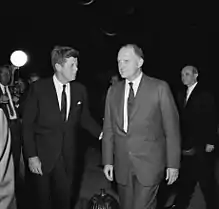
In 1961, John F. Kennedy, appointed Republican Dillon Treasury Secretary. Dillon remained Treasury Secretary under President Lyndon B. Johnson until 1965.
Dillon proposed the fifth round of tariff negotiations under the General Agreement on Tariffs and Trade (GATT), conducted in Geneva 1960–1962; it came to be called the "Dillon Round" and led to substantial tariff reduction. Dillon was important in securing presidential power for reciprocal tariff reductions under the Trade Expansion Act of 1962. He also played a role in crafting the Revenue Act of 1962, which established a 7 percent investment credit to spur industrial growth. He supervised revision of depreciation rules to benefit corporate investment.
Philanthropy
A close friend of John D. Rockefeller III, he was chairman of the Rockefeller Foundation from 1972 to 1975. He also served alongside John Rockefeller on the 1973 Commission on Private Philanthropy and Public Needs, and under Nelson Rockefeller in the Rockefeller Commission to investigate CIA activities. He had been president of Harvard Board of Overseers, chairman of the Brookings Institution, and vice chairman of the Council on Foreign Relations.[3]
Metropolitan Museum of Art
With his first wife, Dillon collected Impressionist art. He was a longtime trustee of the Metropolitan Museum, serving as its President (1970–1977) and then chairman.[3] He built up its Chinese galleries and served as a member of the Museum's Centennial committee.[8] He personally donated $20 million to the museum and led a fundraising campaign, which raised an additional $100 million.[9]
He received the Medal of Freedom in 1989 and was also a member of the Society of the Cincinnati[10] and the Society of Colonial Wars.[9]
Personal life
On March 10, 1931, Dillon married the former Phyllis Chess Ellsworth (1910–1982)[lower-alpha 1] in Boston, Massachusetts. Phyllis was the daughter of John Chess Ellsworth[11] and Alice Frances Chalifoux. The couple had two daughters:
- Phyllis Ellsworth Dillon Collins
- Joan Douglas Dillon (b. 1935), former president of French Bordeaux wine company Domaine Clarence Dillon.
In 1983, the widowed Dillon married the former Susan "Suzzie" Slater (1917-2018). She had first been married to Theodore "Ted" Sheldon Bassett (1911-1983) in 1939 (div.). In 1949 she married British entertainer Jack Buchanan (1891-1957). In 1961 she wed DeWitt Linn Sage (1905-1982), who again left her a widow.
Dillon died of natural causes on January 10, 2003, at the New York-Presbyterian Hospital in New York City at the age of 93.[9]
Descendants
Through his daughter Joan's first marriage, he was a grandfather of Joan Dillon Moseley (b. 1954), and through her second marriage to Prince Charles of Luxembourg,[12] he was a grandfather to Princess Charlotte (b. 1967) and Prince Robert (b. 1968) followed. After Prince Charles' death in 1977, Joan married Philippe-François-Armand-Marie, 8th duc de Mouchy in 1978, without further issue.[13]
In fiction
In the Brendan DuBois novel Resurrection Day (1999), the Cuban Missile Crisis erupts into a full-scale nuclear war and Washington, D.C. is destroyed. President Kennedy is killed, as is Vice President Johnson, most of the Senate and Congress, and most members of the Kennedy administration. Dillon, the Secretary of the Treasury, is eventually found to have survived the war and becomes the 36th President of the United States.
See also
- List of U.S. political appointments that crossed party lines
- Rockefeller Foundation
- Rockefeller family
- Metropolitan Museum
References
- Notes
- Phyllis was born in South Bend, St. Joseph County, Indiana on August 3, 1910 and died in New York City, New York on June 20, 1982.
- Sources
- "National Archives Catalog. Dillon, C. Douglas (Clarence Douglas), 1909-2003. Person Authority Record". National Archives. Retrieved May 1, 2020.
- "C. Douglas Dillon, former Treasury secretary and Harvard overseer, dies at 93". Harvard Gazette. Harvard University news office. January 16, 2003. Retrieved 2009-03-27.
- Eric Pace (January 12, 2003). "C. Douglas Dillon Dies at 93; Was in Kennedy Cabinet". The New York Times. Retrieved 2009-03-27.
- "Dillon, C(larence) Douglas. Priscilla Roberts.The Scribner Encyclopedia of American Lives. Arnold Markoe, Karen Markoe, and Kenneth T. Jackson (editors). Vol. 7: 2003–2005. Detroit: Charles Scribner's Sons, 2007. Reproduced in Biography Resource Center. Farmington Hills, Michigan: Gale, 2009. http://galenet.galegroup.com/servlet/BioRC Via Fairfax County Public Library. Accessed 2009-03-27. Document Number: K2875000085
- "C. Douglas Dillon". John F. Kennedy Presidential Library.
- Rabe, Stephen G. (1999). The Most Dangerous Area in the World: John F. Kennedy Confronts Communist Revolution in Latin America. Chapel Hill: University of North Carolina press. pp. 30–32. ISBN 080784764X.
- Finding aid for the George Trescher records related to The Metropolitan Museum of Art Centennial, 1949, 1960-1971 (bulk 1967-1970) Archived 2019-04-12 at the Wayback Machine. The Metropolitan Museum of Art. Retrieved 5 August 2014.
- Jackson, Harold (24 January 2003). "Douglas Dillon | The Republican behind JFK's economic boom". The Guardian. Retrieved 9 March 2018.
- Society of the Cincinnati (1998). Roster of the Society of the Cincinnati. Washington, DC: Society of the Cincinnati. p. 87.
- Timothy Edward Howard, History of St Joseph County, Indiana, vol II (1907), pp. 886–887
- "Mrs. Joan Dillon Betrothed to Prince; She Will Be Wed in Spring to Charles of Luxembourg". The New York Times. 11 February 1967. Retrieved 22 July 2020.
- Genealogisches Handbuch des Adels, Fürstliche Häuser XVIII. "Luxemburg". C.A. Starke Verlag, 2007, pp. 83–84, 449–450. (German). ISBN 978-3-7980-0841-0.
Further reading
- Nelson Lichtenstein, ed., Political Profiles: The Johnson Years (1976)
- Eleanora W. Schoenebaum, ed., Political Profiles: The Eisenhower Years (1977)
- Bernard S. Katz and C. Daniel Vencill, Biographical Dictionary of the United States Secretaries of the Treasury, 1789–1995 (1996)
- Joseph M. Siracusa, ed., Presidential Profiles: The Kennedy Years (2004)
- Deane F. Heller, The Kennedy Cabinet: America's Men of Destiny (1961)
- Robert Sobel, The Life and Times of Dillon Read (1991), a study of the investment bank
- Robert C. Perez and Edward F. Willett, Clarence Dillon: A Wall Street Enigma (1995), a biography of Dillon's father.
External links
| Diplomatic posts | ||
|---|---|---|
| Preceded by James Clement Dunn |
U.S. Ambassador to France March 13, 1953 – January 28, 1957 |
Succeeded by Amory Houghton |
| Government offices | ||
| Preceded by William L. Clayton |
Under Secretary of State for Economic Affairs July 1, 1958 – June 11, 1959 |
Succeeded by George Wildman Ball |
| Preceded by Christian Herter |
Under Secretary of State June 12, 1959 – January 4, 1961 |
Succeeded by Chester Bowles |
| Preceded by Robert B. Anderson |
U.S. Secretary of the Treasury Served under: John F. Kennedy, Lyndon B. Johnson January 21, 1961 – April 1, 1965 |
Succeeded by Henry H. Fowler |
| Cultural offices | ||
| Preceded by Arthur Amory Houghton Jr. |
President of the Metropolitan Museum of Art 1970-1977 |
Succeeded by William B. Macomber, Jr. |
